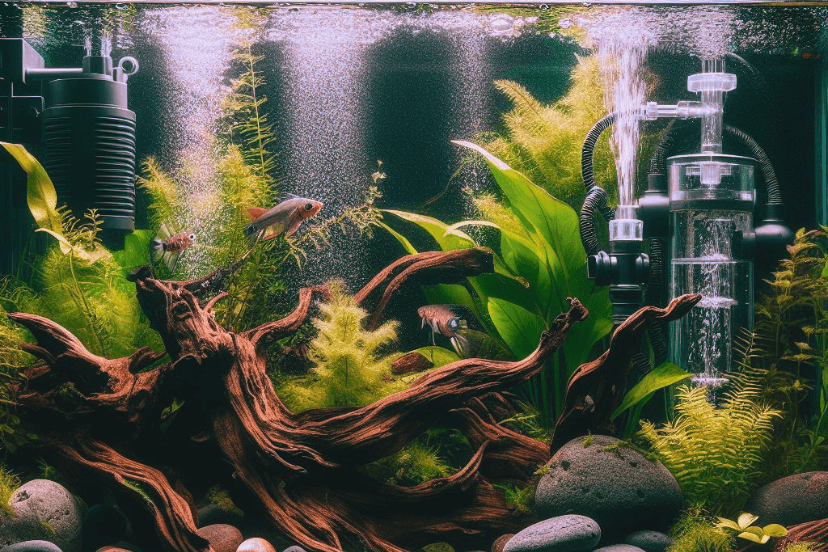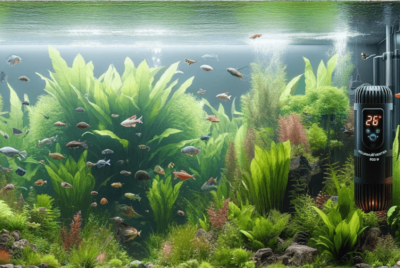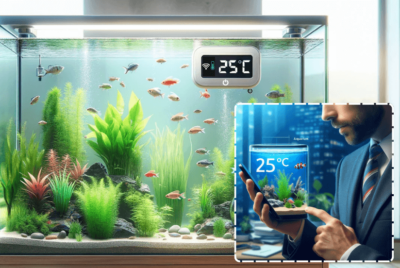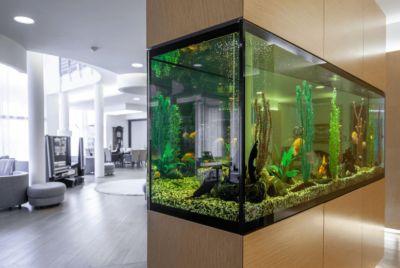Aquarium Pumps: The Ultimate Guide
Hi there! If you’re looking for a guide on aquarium pumps, you’ve come to the right place. When delving into aquarium keeping, the cornerstone of your vibrant underwater ecosystem is the aquarium pump. Opting for the appropriate aquarium pump is vital to uphold a healthy environment, ensuring proper water circulation and oxygenation for your aquatic inhabitants.
The aquarium pump acts as the lifeline of your tank, simulating natural water movement and supporting the well-being of your fish and plants. It’s vital for keeping the water clean and the life within it thriving.
Embracing the role of the aquarium pump is key to a flourishing aquarium. By selecting and maintaining the right pump, you’re ensuring your underwater world remains a vibrant and joyful sanctuary.
Understanding Aquarium Pumps
Types of Aquarium Pumps
Air Pumps
Air pumps truly are the unsung heroes of the aquarium world. They play a crucial role in ensuring the water is well-oxygenated, allowing your fish to breathe with ease. These devices work tirelessly, adding vital air bubbles to the tank, which promotes gas exchange and keeps the aquatic environment fresh and invigorating for its inhabitants.
Water Pumps
They stand as the robust powerhouses of your aquarium setup. They do the heavy lifting, circulating water through the essential components of your tank—filters, heaters, and chillers. This continuous movement is key to sustaining a stable and ideal environment for your aquatic life. Water pumps ensure that every corner of the tank receives the same level of care and quality of water, providing a uniformly healthy habitat for fish and plants alike.
In essence, both air and water pumps are indispensable to maintaining the balance of your aquarium. While air pumps focus on the breathability of the water, water pumps ensure the ecosystem’s overall health by facilitating the flow of water through critical filtration and temperature regulation systems. Together, they create a harmonious environment where your aquatic friends can thrive.
How Aquarium Pumps Work
Think of your aquarium not just as a tank of water, but as a dynamic, living ecosystem. At the core of this vibrant ecosystem is the aquarium pump, serving as its beating heart. This crucial device ensures the continuous flow of water and oxygen, mimicking the natural currents that sustain life under the sea. The pump’s role is vital; it breathes life into the aquarium by distributing essential oxygen and nutrients, and by keeping the water clean and at the right temperature. Without this relentless circulation provided by the pump, the delicate balance of our underwater habitat would be disrupted, leaving our aquatic inhabitants in a precarious situation. It’s the pump that keeps this miniature ocean thriving, ensuring our marine and freshwater friends have the environment they need to flourish.
Choosing the Right Aquarium Pump
Factors to Consider
Selecting the right aquarium pump is essential, and yes, size truly matters! It’s not just about the physical dimensions of the pump but also about matching it to the size of your tank. The amount of water it needs to circulate, the types of fish and plants calling it home, and how quietly it operates are all key factors to keep in mind. After all, creating a serene underwater world doesn’t just mean vibrant visuals; it also means having a peaceful, low-noise environment. So, when you’re on the hunt for the perfect aquarium pump, remember to consider these crucial aspects to ensure your aquatic ecosystem thrives in harmony and health.
Ensuring the Right Flow by Matching Your Aquarium Pump to Tank Size
Choosing the right aquarium pump is crucial for the health of your aquatic friends. The flow rate of your pump should match your tank size to ensure a balanced environment. A too strong flow can stress your fish, while a too weak flow might not filter the water effectively.
First, calculate the volume of your tank. Aim for a pump that can circulate the water at least four times per hour. For example, a 50-gallon tank needs a pump with at least 200 gallons per hour (GPH) flow rate. This balance maintains water quality and mimics natural habitats, making your aquarium a healthy, dynamic ecosystem.
Air Pumps vs. Water Pumps
Choosing the right aquarium pump isn’t a matter of what’s best universally, but what’s best for your unique aquarium setup. Air pumps shine when it comes to providing vital oxygenation for your tank, ensuring your aquatic friends can breathe comfortably. On the other hand, water pumps are the champions of water movement and filtration, keeping your aquarium’s environment clean and well-circulated.
This tailored approach to selecting an aquarium pump ensures that your tank thrives, catering specifically to the needs of your aquatic ecosystem. Whether you’re aiming for optimal oxygen levels with an air pump or seeking efficient water filtration with a water pump, understanding the strengths of each can guide you to make the best choice. So, dive into the specifics of your aquarium’s requirements, and equip it with the pump that promises a healthier, happier home for your aquatic life.
Setting Up Your Aquarium Pump
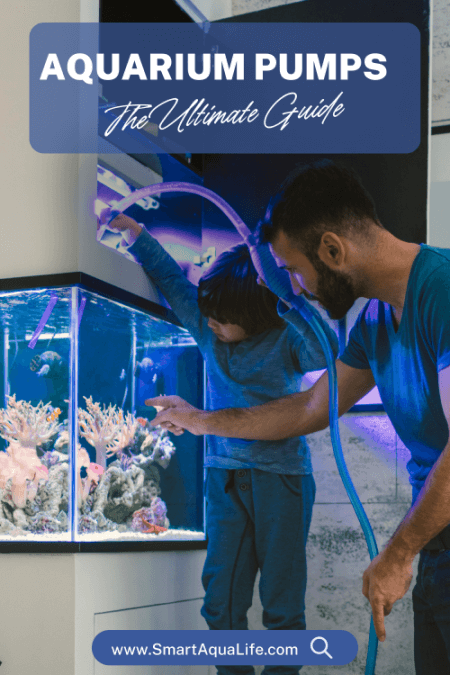
Installation Tips
When installing your aquarium filter, closely adhering to the manufacturer’s instructions is your first step towards ensuring optimal performance. However, there’s an art to positioning your filter that goes beyond the manual. The ideal location is where your pump can work its magic most effectively—this often means finding a spot that enhances water circulation throughout the entire tank without causing a disruptive whirlpool effect. Aim for a balance that spreads the flow evenly, reaching all corners of your aquarium to provide each inhabitant with a clean and healthy environment. This strategic placement not only maximizes the efficiency of your filter but also supports the well-being of your aquatic ecosystem, making it a crucial tip for any aquarist looking to create the perfect underwater habitat.
Safety Measures
When setting up your aquarium pump, prioritize safety to avoid potential hazards. Remember, water and electricity don’t mix well. Always incorporate a drip loop in your setup to prevent water from traveling along the power cord and reaching electrical outlets, reducing the risk of shock or damage to your equipment. Additionally, for added protection and peace of mind, consider using a ground fault circuit interrupter (GFCI) outlet. This specialized outlet detects any imbalances in electrical currents and automatically shuts off power to prevent accidents. By implementing these safety measures, you can enjoy your aquarium hobby with confidence, knowing that you’ve taken essential precautions to safeguard both yourself and your aquatic companions.
Aquarium Pumps Maintenance and Troubleshooting
Routine Maintenance
Maintaining cleanliness is paramount for your pump’s longevity and water clarity. Regularly inspect and clean your pump to remove any debris or buildup, ensuring optimal performance. This simple upkeep routine not only extends the lifespan of your pump but also keeps your aquarium water crystal clear, providing a healthy environment for your aquatic inhabitants to thrive.
Troubleshooting Common Issues
Most pump issues, like strange noises or reduced flow, have straightforward solutions. Often, a thorough cleaning or minor adjustments to the setup can resolve these issues, restoring your pump’s efficiency and ensuring a smoothly functioning aquarium system.
Enhancing Your Aquarium Environment
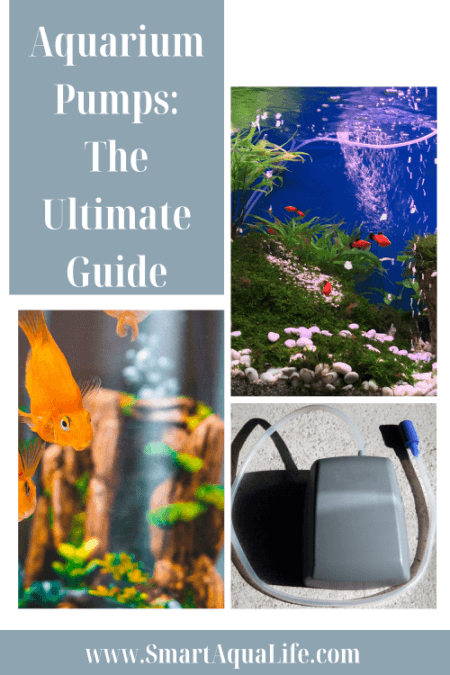
Aquarium Pump’s Benefits for Fish and Plants
Aquarium pumps are indispensable tools in maintaining a vibrant aquatic ecosystem. They go beyond merely moving water within your tank. These pumps create currents that simulate natural water movements. They mimic those found in rivers, lakes, and oceans. This not only adds a touch of wilderness to your home aquarium but also promotes a thriving environment. The flow generated by the pumps is essential for maintaining the delicate balance. It’s needed for a diverse range of aquatic life to prosper.
Moreover, the role of aquarium pumps in facilitating gas exchange cannot be overstated. They ensure constant motion on the water’s surface, facilitating oxygen absorption and carbon dioxide expulsion. This process is crucial for sustaining life within the tank, benefiting fish, plants, and beneficial bacteria alike. By mimicking natural habitats and promoting healthy gas exchange, aquarium pumps transform static water. They turn it into a dynamic, flourishing ecosystem, a cornerstone of successful aquarium setups.
Smart Aquarium Pumps
Smart aquarium pumps are revolutionizing fishkeeping by automatically adjusting to your tank’s needs, simplifying maintenance. These innovative pumps monitor water conditions and adjust flow rates to ensure a healthy environment, making them ideal for any aquarium setup.
Equipped with sensors, smart pumps react to changes, reducing the need for manual adjustments. They’re compatible with both freshwater and marine ecosystems, enhancing the well-being of all aquatic life.
Moreover, these pumps can be controlled via smartphone, offering convenience and peace of mind to aquarists. This advancement in aquarium technology makes fishkeeping more accessible and enjoyable, streamlining care for enthusiasts around the globe.
Conclusion
Choosing the right aquarium pump and maintaining it properly are crucial steps to ensure the health and happiness of your aquatic ecosystem. By adhering to the expert advice we’ve outlined, you’re well on your way to excelling in aquarium maintenance. An aquarium pump is the lifeline of your tank, pivotal for maintaining crystal-clear water. It ensures your fish are lively and content. This foundational step is essential for anyone looking to create a flourishing underwater habitat.
Our guide offers a plethora of tips and insights to help you select the ideal pump for your aquarium. It also provides guidance on keeping it in optimal condition. Implementing these strategies will enable you to provide the best possible environment for your aquatic life. It will transform your tank into a welcoming oasis.
Embrace the journey of aquarium care with enthusiasm. Know that with each piece of advice followed, you’re crafting an aquatic paradise. Your dedication and the right techniques will soon position you as an aquarium pump aficionado. You’ll be eager to share your knowledge and passion with fellow aquarists.
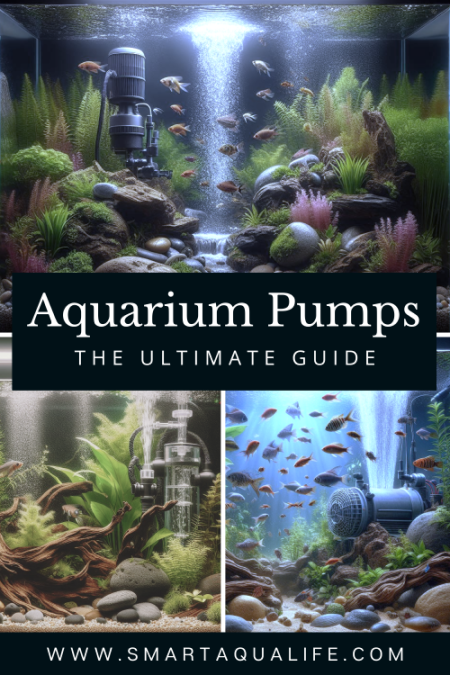
Aquarium Pumps FAQs
Q: How do I choose the right pump size for my aquarium?
A: Consider factors like tank volume, aquatic life, and setup needs. Aim for a pump that can circulate the tank’s volume 4-5 times per hour. A 50-gallon tank requires a pump moving 200-250 gallons per hour (GPH). However, prioritize the comfort of your fish and plants.
Q: Can I use both air and water pumps in my tank?
A: Yes, using both can benefit your aquarium. An air pump increases oxygen levels and surface agitation, while a water pump aids circulation and filtration. Combining them creates an ideal environment, especially in larger tanks.
Q: What if my pump gets noisy?
A: Noise can indicate installation issues or debris obstruction. Ensure proper installation and cleanliness, checking for worn-out parts like the impeller. Cleaning and adjusting should solve most noise problems.
Q: How often should I clean my aquarium pump?
A: Clean every 1-3 months, considering pump type and tank size. Regular maintenance extends pump life. Disassemble if possible and remove accumulated debris, especially around the impeller and intake areas.
Q: Are smart aquarium pumps worth it?
A: Yes, smart pumps offer precise control, programmable cycles, and remote monitoring, mimicking natural habitats for healthier aquatic life. They’re also energy-efficient, potentially saving money in the long run, making them a worthy investment for serious fish keepers.

